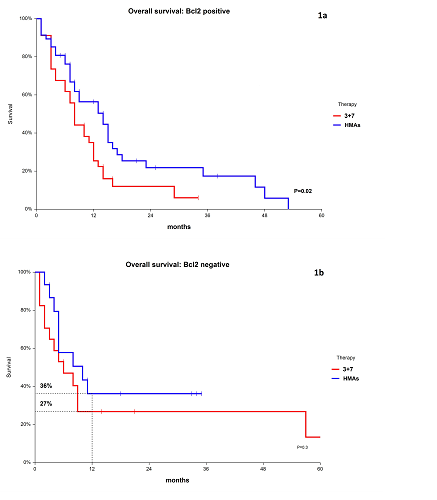
Contributions
Abstract: EP477
Type: E-Poster Presentation
Session title: Acute myeloid leukemia - Clinical
Background
Bcl-2 overexpression has been associated with resistance to chemotherapy and reduced survival in acute myeloid leukemia (AML), but few data are available in elderly patients, a subset accounting for majority of AML cases and with dismal prognosis. Promising results have been reported with the use of bcl-2 inhibitor venetoclax.
Aims
We aimed to elucidate the prognostic role of bcl2 expression in elderly AML and its impact on outcomes across different therapeutic strategies, i.e. conventional 3+7 chemotherapy or hypomethylating agents (HMAs).
Methods
We retrospectively analyzed 114 AML patients aged >65 years treated with induction 3+7 chemotherapy (n=51) or HMAs decitabine or azacytidine (n=62) at the Division of Hematology of the University of Udine from 2010 to 2019. Bcl-2 expression on leukemic blasts was tested by flow cytometry, results were expressed as the mean fluorescence index (MFI) and bcl-2 was considered overexpressed for an MFI ≥17). Complete remission (CR) was defined according to conventional ELN 2017 criteria after one 3+7 course or 3-4 HMAs cycles; overall survival (OS) probability was estimated by the KM method.
Results
The characteristics of the 114 patients at diagnosis were: median age 68 years (range: 65-85); de novo AML n=49 (43%) and secondary AML n=65 (57%); leukocytes >30x109/L n=27 (24%); CD34-positive n=91 (80%); CD56-positive n=36 (32%); ELN 2017 genetic risk: favorable n=17 (15%), intermediate n=48 (42%), adverse n=49 (43%). Fifty-one patients (45%) received 3+7 induction chemotherapy while 62 patients (55%) were treated with HMAs.
Bcl-2 was expressed in 81 patients (71%), without differences according to clinical and biological variables in bcl-2 positive and negative AML. CR was achieved in 36%, being equal in bcl-2+ and bcl-2- patients; in bcl-2 positive cases, CR rate was higher with HMAs (20/44, 45.5%) than with 3+7 (8/34, 23.5%; p=0.04). One-year OS in the entire population was 39%, without differences among bcl-2+ (42%) and bcl-2- (32%) cases and with a trend toward a superior 1-year OS in patients treated with HMAs compared to 3+7 (51% vs 26%, p=0.07). The only factors affecting survival in multivariable analysis were WBC count (OR=3.2) and ELN risk (OR=3.0 for intermediate risk and OR=15.8 for adverse risk). While bcl-2 expression and induction therapy per se had no impact on OS in the whole cohort, when analyzing patients according to bcl-2 expression we found a significant better survival with HMAs than chemotherapy in bcl-2 positive cases (1-year OS 56% vs 25%, p=0.02, OR=1.8 – figure 1a) while no differences were found in bcl-2 negative ones (1-year OS 36% with HMAs and 27% with 3+7, p=0.3 – figure 1b).

Conclusion
Bcl-2 overexpression was not associated with inferior CR rate or survival in elderly AML, but bcl-2 positivity, that is preeminent among patients over 65 years, seems to be associated with a more favorable response to HMAs compared to conventional chemotherapy. Thus, the combination of HMAs with venetoclax appears to be particularly appealing in bcl-2 overexpressing patients.
Keyword(s): AML, BCL2, Elderly
Abstract: EP477
Type: E-Poster Presentation
Session title: Acute myeloid leukemia - Clinical
Background
Bcl-2 overexpression has been associated with resistance to chemotherapy and reduced survival in acute myeloid leukemia (AML), but few data are available in elderly patients, a subset accounting for majority of AML cases and with dismal prognosis. Promising results have been reported with the use of bcl-2 inhibitor venetoclax.
Aims
We aimed to elucidate the prognostic role of bcl2 expression in elderly AML and its impact on outcomes across different therapeutic strategies, i.e. conventional 3+7 chemotherapy or hypomethylating agents (HMAs).
Methods
We retrospectively analyzed 114 AML patients aged >65 years treated with induction 3+7 chemotherapy (n=51) or HMAs decitabine or azacytidine (n=62) at the Division of Hematology of the University of Udine from 2010 to 2019. Bcl-2 expression on leukemic blasts was tested by flow cytometry, results were expressed as the mean fluorescence index (MFI) and bcl-2 was considered overexpressed for an MFI ≥17). Complete remission (CR) was defined according to conventional ELN 2017 criteria after one 3+7 course or 3-4 HMAs cycles; overall survival (OS) probability was estimated by the KM method.
Results
The characteristics of the 114 patients at diagnosis were: median age 68 years (range: 65-85); de novo AML n=49 (43%) and secondary AML n=65 (57%); leukocytes >30x109/L n=27 (24%); CD34-positive n=91 (80%); CD56-positive n=36 (32%); ELN 2017 genetic risk: favorable n=17 (15%), intermediate n=48 (42%), adverse n=49 (43%). Fifty-one patients (45%) received 3+7 induction chemotherapy while 62 patients (55%) were treated with HMAs.
Bcl-2 was expressed in 81 patients (71%), without differences according to clinical and biological variables in bcl-2 positive and negative AML. CR was achieved in 36%, being equal in bcl-2+ and bcl-2- patients; in bcl-2 positive cases, CR rate was higher with HMAs (20/44, 45.5%) than with 3+7 (8/34, 23.5%; p=0.04). One-year OS in the entire population was 39%, without differences among bcl-2+ (42%) and bcl-2- (32%) cases and with a trend toward a superior 1-year OS in patients treated with HMAs compared to 3+7 (51% vs 26%, p=0.07). The only factors affecting survival in multivariable analysis were WBC count (OR=3.2) and ELN risk (OR=3.0 for intermediate risk and OR=15.8 for adverse risk). While bcl-2 expression and induction therapy per se had no impact on OS in the whole cohort, when analyzing patients according to bcl-2 expression we found a significant better survival with HMAs than chemotherapy in bcl-2 positive cases (1-year OS 56% vs 25%, p=0.02, OR=1.8 – figure 1a) while no differences were found in bcl-2 negative ones (1-year OS 36% with HMAs and 27% with 3+7, p=0.3 – figure 1b).

Conclusion
Bcl-2 overexpression was not associated with inferior CR rate or survival in elderly AML, but bcl-2 positivity, that is preeminent among patients over 65 years, seems to be associated with a more favorable response to HMAs compared to conventional chemotherapy. Thus, the combination of HMAs with venetoclax appears to be particularly appealing in bcl-2 overexpressing patients.
Keyword(s): AML, BCL2, Elderly


